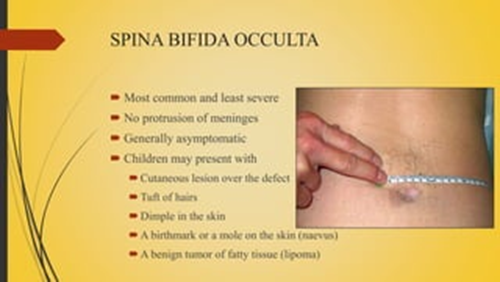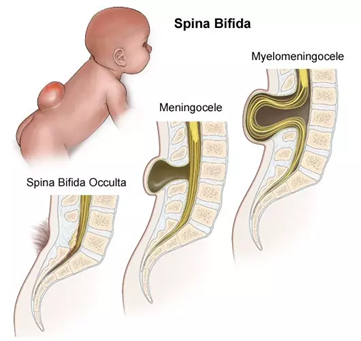A nurse is collecting data from a child who has spina bifida occulta. Which of the following findings should the nurse expect?
Flaccid paralysis of lower extremities
Hip dislocation
Hydrocephalus
Dimple in sacral area
The Correct Answer is D
A. Flaccid paralysis of lower extremities:
Flaccid paralysis refers to a weakness or loss of muscle tone in the affected muscles, leading to decreased or absent movement. This finding is not typically associated with spina bifida occulta. Instead, it is more commonly seen in more severe forms of spina bifida, such as myelomeningocele, where there is significant involvement of the spinal cord and nerves.
B. Hip dislocation:
Hip dislocation can occur in individuals with myelomeningocele due to muscle weakness, abnormal muscle tone, and joint deformities associated with spinal cord defects. However, it is not typically associated with spina bifida occulta, which usually presents with less severe spinal cord involvement.
C. Hydrocephalus:
Hydrocephalus, characterized by the accumulation of cerebrospinal fluid within the brain, is a common complication of myelomeningocele due to disturbances in the flow and absorption of cerebrospinal fluid caused by the spinal defect. It is less commonly associated with spina bifida occulta, which typically involves a less severe spinal cord defect.
D. Dimple in sacral area:
This is the correct choice. A dimple, patch of hair, or birthmark in the lower back or sacral area is a common finding in spina bifida occulta. It occurs due to the incomplete closure of the spinal column during fetal development, leading to a small defect in the vertebrae. This is often a subtle manifestation of spina bifida occulta and may not cause significant symptoms or functional impairment.

Nursing Test Bank
Naxlex Comprehensive Predictor Exams
Related Questions
Correct Answer is B
Explanation
A. Methylprednisolone: Methylprednisolone is a corticosteroid used for long-term management and prevention of asthma exacerbations. It has anti-inflammatory effects and is not typically used for immediate relief during an acute asthma attack.
B. Albuterol: Albuterol is a short-acting beta-agonist bronchodilator, which is the first-line medication for relieving acute bronchoconstriction during an asthma attack. It works quickly to open the airways and improve breathing.
C. Fluticasone: Fluticasone is an inhaled corticosteroid used for long-term asthma control and prevention of symptoms. It has anti-inflammatory effects but is not used for immediate relief during an acute asthma attack.
D. Beclomethasone: Beclomethasone is also an inhaled corticosteroid used for long-term asthma control and prevention of symptoms. Like fluticasone, it is not used for immediate relief during an acute asthma attack.
Correct Answer is D
Explanation
A. Promote maternal-infant bonding: While promoting maternal-infant bonding is essential for the overall well-being of the newborn and family, it may not be the priority in this situation. The immediate focus is on medical management and preventing complications associated with the myelomeningocele.
B. Provide age-appropriate stimulation: Age-appropriate stimulation is important for newborn development, but in the case of a newborn with a myelomeningocele awaiting surgery, the priority is to minimize any potential risk of injury or infection to the exposed neural tissue.
C. Educate the parents about the defect: Education about the myelomeningocele and its long-term implications is crucial for the parents' understanding and ability to care for their child. However, while important, this may not be the priority at the immediate moment.
D. Maintain integrity of the sac: This is the priority nursing goal in caring for a newborn with a myelomeningocele awaiting surgery. The sac covering the exposed neural tissue must be carefully protected to prevent infection and further damage. Measures such as keeping the sac moist with sterile saline dressings and preventing trauma to the area are essential to maintain its integrity.

Whether you are a student looking to ace your exams or a practicing nurse seeking to enhance your expertise , our nursing education contents will empower you with the confidence and competence to make a difference in the lives of patients and become a respected leader in the healthcare field.
Visit Naxlex, invest in your future and unlock endless possibilities with our unparalleled nursing education contents today
Report Wrong Answer on the Current Question
Do you disagree with the answer? If yes, what is your expected answer? Explain.
Kindly be descriptive with the issue you are facing.
